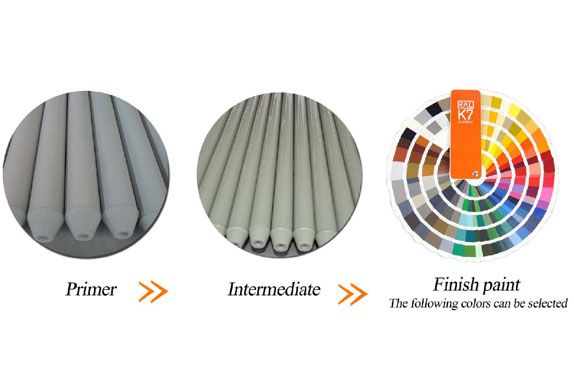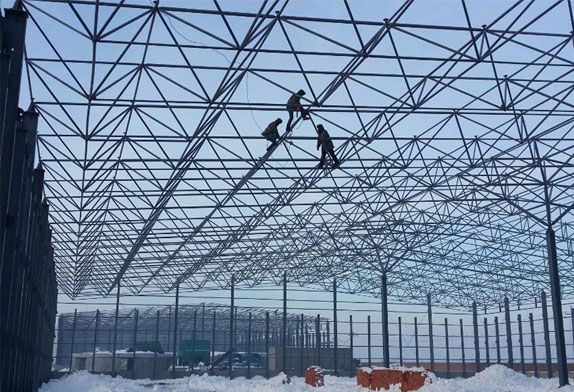
Good anti-corrosion protection quality can not only ensure the overall quality of construction projects but also play a key role in ensuring their service life and safety. Therefore, in the construction process of a specific steel structure building project, the construction unit must pay attention to the anti-corrosion protection work, and do a good job in the quality control of the anti-corrosion protection project through a reasonable approach.
1 Corrosion mechanism and harm of steel structure buildings
Because metals can react with dry gases such as carbon dioxide, oxygen, hydrogen sulfide gas, nitrogen, etc., they can also react with non-electrolytes such as lubricating oil and gasoline, or with liquid media, moist gases, aqueous solutions, or electrolyte solutions, etc. Contact reactions occur, all of which will lead to chemical corrosion of the steel structure. If the air humidity is 100%, hydrochloric acid, ammonia, chlorine, sulfur dioxide, etc. in the atmosphere will be dissolved by the water film attached to the metal surface, and then form “acid rain”, causing more severe corrosion to the metal structure. If the steel structure building is corroded, the original stiffness, strength and bearing capacity of the steel structure will be adversely affected. Threats to the personal safety and property safety of users. Therefore, it is necessary to effectively avoid the corrosion problem of steel structures through reasonable anti-corrosion protection measures.
2 Analysis of quality control measures for anti-corrosion protection of steel structure construction projects
2.1 Application of weathering steel
Weathering steel has better corrosion resistance than ordinary structural steel, which contains copper, zinc, phosphorus, nickel, chromium and other metals, so that a protective film can be formed on its surface to effectively improve its corrosion resistance performance. At the same time, compared with ordinary steel structures, weathering steel also has better low temperature impact toughness. Therefore, applying it to steel structure construction projects will further enhance its anti-corrosion effect.
2.2 Application of hot dip galvanizing
The so-called hot-dip galvanizing is to remove the rust from the steel components and enter them into a high-temperature zinc solution of about 600 ° C, so that the zinc layer is attached to the surface of the steel components. If the thickness of the sheet is less than 5mm, the thickness of the zinc layer should exceed 65μm; if the thickness of the steel plate is more than 5mm, the thickness of the zinc layer should exceed 86μm, so that a good anti-corrosion effect can be achieved. Such anti-corrosion methods have been widely used in a large number of communication towers and transmission towers.
2.3 Application of thermal spray aluminum or zinc composite coating
Compared with hot-dip galvanizing, this method has the same long-term effect in the corrosion resistance of steel structure buildings. In the application of this method, it is first necessary to do a good job of surface treatment of the steel structure by sandblasting and rust removal to make it appear metallic luster, and to do a roughening treatment. Then, the aluminum wire or zinc wire is continuously sent out and melted through the acetylene-oxygen flame, and then the hammer is attached to the surface of the steel structure with the help of compressed air, so that the aluminum or zinc spray layer is honeycomb-shaped, and its thickness should be controlled at 80~ between 100μm. Finally, the capillary holes are filled with the help of cyclobutane rubber or epoxy resin, so that a layer of composite coating is formed, so as to achieve a good anti-corrosion effect.
2.4 Application of the coating method
Compared with the longer-term anti-corrosion method, the effect of this method will be relatively poor, but the current fluorocarbon coating can also maintain the anti-corrosion effect for nearly 50 years. Therefore, for indoor steel structures that are easier to maintain, the coating method can be reasonably applied, which can not only meet the actual anti-corrosion requirements but also save costs.

3 Analysis of quality inspection measures for anti-corrosion protection engineering of steel structure buildings
3.1 Main control items
In the process of anti-corrosion protection of steel structure buildings, first of all, the surface rust treatment must be done in accordance with the relevant national standards before construction, and anti-corrosion construction can only be carried out on the basis of ensuring the quality of rust removal; In the control, the first is to control the number of inspections. Usually, it is necessary to conduct random inspections according to 10% of the total number of components, and ensure that the number of random inspections of the same type of components is more than 3; the second is to control the inspection methods. The specified standard should be checked against the pictures. If there is no design requirement for the coating thickness, the total thickness of the outdoor dry paint coating film should be controlled above 150μm, and the indoor should be controlled above 120μm, and the allowable error should be within 25μm. The allowable error should be less than 5μm.
In the specific inspection, if it is applied to the dry paint film thickness gauge, each component should be inspected at five points, each with three detection points, and the distance between each point should be controlled at about 50mm, and then take the average thickness and stipulated standard comparison.
3.2 General inspection items
(1) The surface of steel components should not be missed, mispainted, rusted, or peeled;
(2) Number of inspections: all steel components to be inspected need to be inspected;
(3) Inspection method: observation and inspection method.
To sum up, in the construction of steel structure buildings, the construction unit should clarify the corrosion mechanism and hazards, do a good job in the quality control of anti-corrosion protection, and do a good job in the corresponding anti-corrosion quality inspection. In this way, the quality of the project can be effectively guaranteed and the safety of the project can be improved.











 About Us
About Us 2023-01-28
2023-01-28


